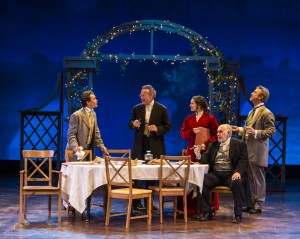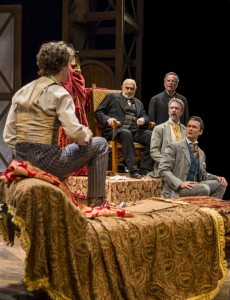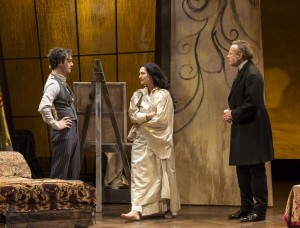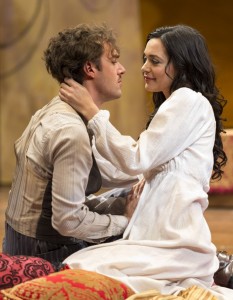JUST WHAT THE DOCTOR ORDERED
Even though the legislation for a public health care option passed by Democratic majority in Congress, matters of wellness and proper treatment are anxieties that still plague the hearts, souls, and minds of all mortal individuals. It concerns us greatly because we hunger to make the most of our lives; having more time allows us more opportunity to make that possible. Doctors are valuable individuals to the public because they have the supposed knowledge and skills required to prolong our lives for our own purposes. And while most people seek to carve out their legacy through different means, a doctor has a neatly etched legacy with every patient they make well. Never mind that patients may perish’”after all, a doctor’s mistakes are forgiven because their field of work is a practice. George Bernard Shaw’s The Doctor’s Dilemma is laced with invectives against medical practitioners and affectionate defense for amoral artists. It is rife with irreverent humor at both parties’ expense, and upon closer analysis it dissects the values of meaningful relationships, and offers judgment on the merits of an everlasting legacy.
The piece centers on Sir Colenso Ridgeon, recently knighted for his revolutionary discovery (a tuberculosis treatment), and his decision to cure either his bland, honest colleague Dr. Blenkinsop or a colorful scoundrel, the talented artist Louis Dubedat, both of whom are suffering from tuberculosis. Complicating the matter is the fact that Sir Colenso finds himself attracted to Louis Dubedat’s wife, and that Dr. Blenkinsop can’t pay for the treatment. What is a Doctor to do? A Noise Within’s second production of their second season in their new permanent home is a weighty but lively undertaking of The Doctor’s Dilemma. With a running time of two hours and forty minutes–plus a fifteen-minute intermission between Acts two and three (of five), it is important to be well-prepared for a long, chatty evening of wit and sophistication.
Geoff Elliott stars as the conflicted titular Doctor, Sir Colenso Ridgeon, and may be unsung because of the flashier nature of the supporting cast. However, his full-bodied portrayal of the out-of-sorts and out-of-his-depth intellectual is fraught with intensity, urbanity, and a tenderness that never slips into sentimentality; Elliott consistently compels by walking on that very narrow line. Apollo Dukakis becomes a hulking part of the scenery and plays his grandfatherly role of Sir Patrick Cullen with a pleasantly measured gruffness. David LM McIntyre is wonderful in his dual roles as Dr. Blenkinsop and the Newsman. As Blenkinsop he provides a nebbishy, sympathetic portrayal of a man who wants to be treated fairly, but so desperately needs extra help, and as the Newsman, he transforms into a smug, self-important imbecile. Freddy Douglas as Cutler Walpole and Robertson Dean as Sir Ralph Bloomfield “BB” Bonington are boisterous, effervescent, and energize the proceedings with a perpetual zest that makes the phrases “stimulate the phagocytes” and “blood poisoning” burst with life and generate many laughs.
Kelly Ehlert stands tall with her fellow players on the stage in her ANW debut as Minnie Tinwell, the earnest maid. Jason Dechert is magnificent in his portrayal of the full-blown narcissistic rascal artist; charming and abrasive, he also showcases the voracious contempt of everything that is not his or to his liking with a magnetic debonair flair. Deborah Strang’s Emmy is evidence that a small part does not make a small character; Strang chews up the scenery as the dirty, lower-class, maid-servant, and so embodies the role with a playfulness and assured confidence that it makes sense Emmy can do as she pleases’”much to the chagrin and befuddlement of those above her.
It is peculiar that Redpenny (Rafael Goldstein) was played differently than as dictated deliberately by Shaw; the choice did not pay off. The character is supposed to be an eager-eyed, wet-behind-the-ears individual, and instead it is performed with a focused terseness. Jules Willcox as Jennifer Dubedat is perhaps more beautiful than Shaw envisioned, not merely in visage but performance as well. Genetically designed for this role, she offers an exceptional interpretation as the refined, commanding, naïve woman. With her fierce resolve, the last scene between her and Sir Colenso stuns the audience as she judges, humiliates, and inevitably annihilates the celebrated doctor.
Susan Gratch’s scenic design is spacious and sumptuous. One fine detail is a skeleton that is drably placed in Sir Colenso’s consulting room, but cleverly outfitted and situated in Mr. Dubedat’s studio. Leah Piehl’s late-Victorian/Edwardian era costumes are elegant. They drape the players radiantly and allow them to smoothly sink in the skin of their characters. Doug Newell’s music helps maintain the sophisticated atmosphere of the proceedings and provides a stirring coda to the already powerful conclusion.
The production succeeds in its casting, its pacing, its dressing, and its staging; its execution is fluid and dynamic. And that is a credit to Dámaso Rodriguez and his team. However, in the words of Peter Falk’s Columbo, “there’s just one other thing.” While all the aforementioned praises are true, Rodriguez earns the blame for one, unnecessary and avoidable mistake. The mistake: not presenting the play as written. The audience is deprived of George Bernard Shaw’s The Doctor’s Dilemma in full. Rodriguez decides to play Doctor and operate an unnecessary surgery on the piece itself. Not only were lines removed, but the character of Dr. Leo Schutzmacher is completely excised from this production, too. One may quickly argue that it was done for a matter of time’s sake, but the amount of time (12 minutes) removed is hardly consequential to the three-hour affair. And while his time in the play is brief, Dr. Leo Schutzmacher is vital to the piece because of his enlightened commentary on Englishmen and borrowing money, his symbolic stature as a doctor to the middle-class public, and his distinctive perspective being an outsider; a Jew amongst Englishmen. Is such an excision grounds to not see the play? Certainly not. However, it is what separates it from being a greatly realized production, and it settles upon the plateau of very, very good, instead.
photos by Craig Schwartz
The Doctor’s Dilemma
A Noise Within in Pasadena
ends on November 25, 2012
for tickets, call 626-356-3100 or visit A Noise Within





